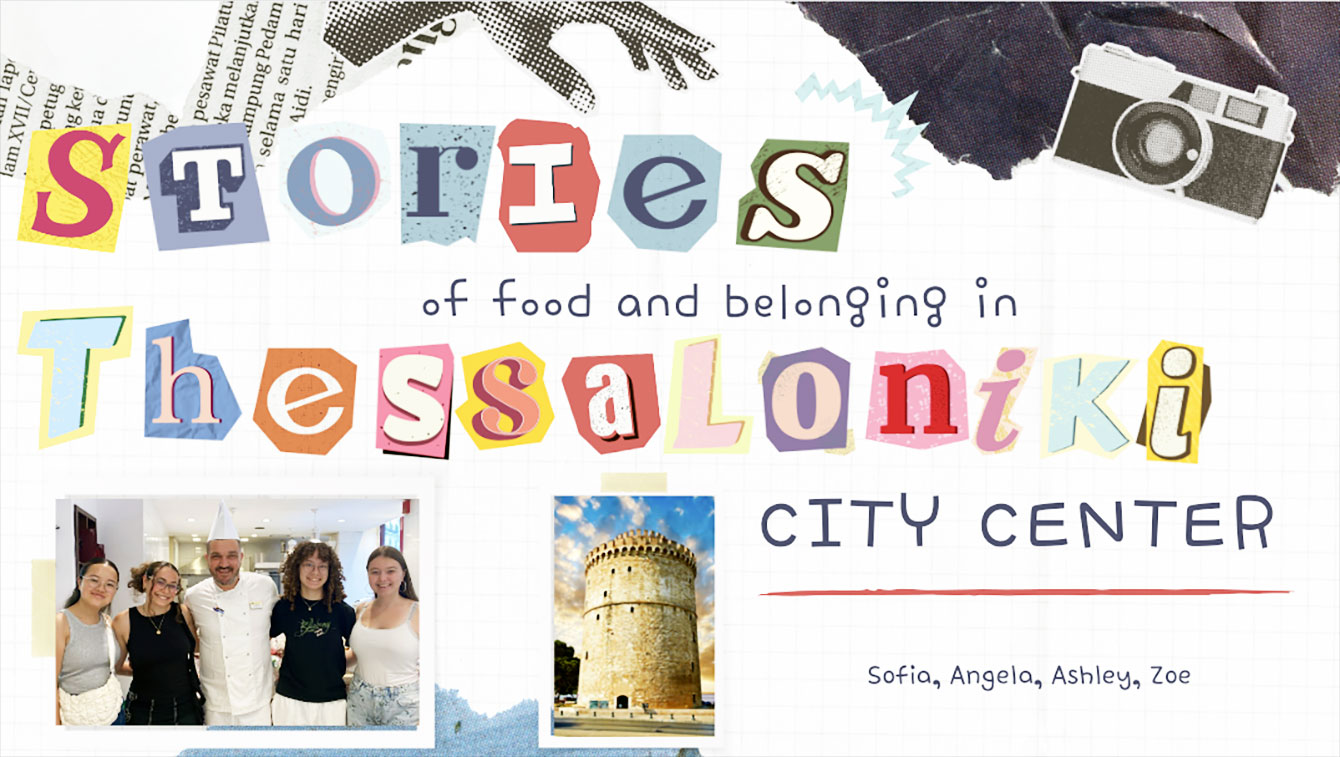In Thessaloniki, students explore ‘relationship between migration, food, and belonging’
Since international migration became legally restricted in the early 20th century, millions of people have fled their homelands involuntarily, moving across the world and settling into new communities.
In “forced migration,” as the United Nations’ International Organization for Migration calls it, what happens when refugees join a new community? How do they adjust to different cultures and languages? How do they feel at home, like they belong, in a community that may or may not welcome them? And how might a community be transformed by migrants?
Eleven Clark undergraduate students investigated these questions this summer in Greece, researching the history of forced migration and settlement through the lens of food and culture. Their work was part of Clark’s newly developed study abroad course, People-on-the-Move Research Studio: Food, Migration, and Belonging in Thessaloniki, funded in part by the Leir Program.
Co-taught by Professor Anita Fábos and research scholar Leora Kahn of the Department of Sustainability and Social Justice, the Studio Course was one of the department’s many Global Learning Collaboratives, which allow students to participate in hands-on learning experiences with community partners in different parts of the world. Fábos and Kahn lead Clark’s Integration and Belonging Hub, which supports collaboration and research around fostering migrant- and refugee-inclusive communities locally, nationally, and globally.
Drawing students from a variety of undergraduate majors, the course met in Thessaloniki, the second-largest city in Greece, known for its rich food culture. In 2021, UNESCO named Thessaloniki a “City of Gastronomy” for chefs’ use of fresh ingredients and the production of feta, yogurt, and olive oil.
The students had plenty of opportunities to try cuisine from many cultures, guided by Panagiotis “Panos” Karafoulidis, a chef, former director of the Thessaloniki Culinary Arts Institute, and founder of Gastro Routes, which offers tasting tours. Over four weeks, they visited restaurants, bakeries, food markets, and a village home to Karafoulidis’ family of Anatolian Christian refugees and their descendants.
“He had set up an entire program for us, including observing women who were preparing for a wedding, cooking produce from his garden, and cooking over a fire,” Fábos says. “He knew how to work with and teach young people, and as a person from a refugee background himself, he knew the unique food culture of Thessaloniki really well.”
Sitting at the crossroads between Asia and Europe, Thessaloniki has a long history of attracting, and providing refuge to, migrants. But like many countries, Greece has experienced a migrant crisis in the 21st century. In 2015, nearly 1 million people from Africa, the Middle East, and Asia arrived on rickety rafts and boats to the Greek islands. Still today, many pass through Greece on their way to other countries in the European Union.
“Even though there’s a welcoming tradition in Greece,” Fábos says, “today there isn’t a lot of refugee settlement.”
The course focused on the waves of migrants who came much earlier — going back as far as the 15th century, when Spain expelled Jews during the Inquisition. Many more migrants were forced to move to Greece after the collapse of the Ottoman Empire in the early 20th century. Thessaloniki’s significant Jewish population was destroyed by Nazi deportations in 1943.
Today, however, Thessaloniki recognizes the rich history and culture of past and present Jewish inhabitants through a museum of Jewish history, an educational program, and a revival of Jewish cuisine. At Akademos Restaurant, a chef prepared a meal for Clark students using collected recipes of the Jewish community of Thessaloniki.
“We wanted the students to understand: What is the relationship between migration, food, and belonging?” Fábos says.
The students’ group projects focused on three neighborhoods: City Center, Ano Poli (“Old Town”), and Kalamaria. Besides Jews, the city became home to descendants of migrants from former Anatolia (or Asia Minor), now part of Turkey, and to those fleeing after the Greco-Turkish War (1919-22).
As the Clark students interviewed neighborhood residents, undergraduate journalism and media studies students from Aristotle University of Thessaloniki served as translators.
“They had to approach the sellers, the cooks, the restauranteurs, and the customers and ask them what it meant to be part of this food culture in that neighborhood. How did their families start their businesses? Was there a migrant story?” Fábos says. “They got to know the neighborhoods really well, and their projects were amazing.
“The students really grasped that integration is the process of ‘becoming together,’ ” she adds. “It’s the old and new transforming each other.”
For their final projects, students on the Ana Poli team used GIS skills to create a story map; the City Center group designed an online scrapbook filled with research, stories, maps, and photos; and the Kalamaria students produced a video of interviews with migrants and their descendants.
The students integrated what they had learned from guest faculty in anthropology, archaeology, history, filmmaking, and Thessaloniki’s food and culture. Eftihia Voutira, one of the founders of the field of refugee and forced migration studies and an emerita professor at the University of Macedonia’s Department of Balkan, Slavic and Oriental Studies, gave an overview of the history of forced migration in northern Greece.
Source: https://clarknow.clarku.edu




